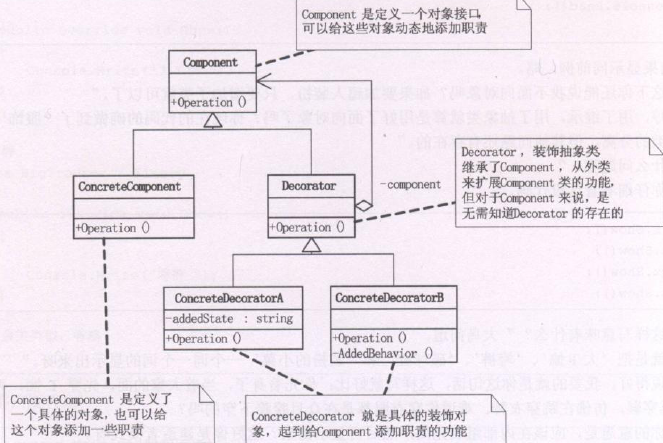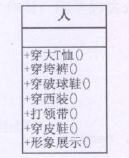第六章 穿什么有这么重要-装饰模式(读书笔记)
来源:互联网 发布:汉王文本王软件 编辑:程序博客网 时间:2024/04/28 12:33
第六章 穿什么有这么重要-装饰模式
1.装饰模式(Decorator):动态地给一个对象添加一些额外的职责,就增加功能来说,装饰模式比生成子类更加灵活。
2.(图6.4)Component是定义一个对象接口,可以给这些对象动态地添加职责。ConcreteComponent是定义了一个具体的对象,也可以给这个对象添加一些职责。Decorator:装饰抽象类,继承了Component从外类来扩展Component类的功能,但对于Component来说,是无需知道Decorator的存在的.至于ConcreteDecorator就是具体的装饰对象,起到给Component添加职责的功能。
3.装饰模式是利用SetComponent来对对象进行包装的。这样每个装饰对象的实现就和如何使用这个对象分离开了,每个装饰对象只关心自己的功能,不需要关心如何被添加到对象链当中。
4.装饰模式是为己有功能动态地添加更多功能的一种方式。当系统需要新功能的时候,是向旧的类中添加新的代码。这些新加的代码通常装饰了原有类的核心职责或主要行为。
5.装饰模式可以让你全副武装到牙齿,也可以让你只挂一丝到内裤。
6.装饰模式的优点是:把类中的装饰功能从类中搬移去除,这样可以简化原有的类。最大的好处是有效地把类的核心职责和装饰功能区分开了。而且可以去除相关类中重复的装饰逻辑。
7.保证装饰类之间彼此独立,这样他们就可以以任意的顺序进行组合了。
图6.4 装饰模式的UML图

----------------------------------------------------------------------------------------------------------------------
6.2 小菜扮靓第一版

6.2程序 小菜扮靓第一版程序实现。如果要增加超人的装扮的话,就会违反开放封闭原则。
6.2.1 Person.h
#pragma once#include <string>#include <iostream>class Person{public:Person(std::string name){m_Name = name;};void WearTShirts(void){std::cout << "大T恤" << std::endl;};void WearBigTrouser(void){std::cout << "垮裤" << std::endl;};void WearSneakers(void){std::cout << "破球鞋" << std::endl;};void WearSuit(void){std::cout << "西装" << std::endl;};void WearTie(void){std::cout << "领带" << std::endl;};void WearLeatherShoes(void){std::cout << "皮鞋" << std::endl;};void Show(void){std::cout << "装扮的" << m_Name << std::endl;};private:std::string m_Name;};
6.2.2 客户端程序
#include "stdafx.h"#include "Person.h"int _tmain(int argc, _TCHAR* argv[]){Person* person = new Person("小菜");std::cout << "第一种装扮" << std::endl;person->WearBigTrouser();person->WearTShirts();person->WearSneakers();person->Show();std::cout << "第2种装扮" << std::endl;person->WearSuit();person->WearLeatherShoes();person->WearTie();person->Show();return 0; }----------------------------------------------------------------------------------------------------------------------
6.3 小菜扮靓第二版(图6.3) 用了继承和抽象类。

6.3 小菜扮靓第二版的代码实现
6.3.1 Person.h
#pragma once#include <string>#include <iostream>class Person{public:Person(std::string name){m_Name = name;};void Show(void){std::cout << "装扮的" << m_Name << std::endl;};private:std::string m_Name;};//服饰抽象类class Finery{public:virtual void Show(void) = 0;};class TShirts :public Finery{public:void Show(void){std::cout << "大T恤" << std::endl;};};class BigTrouser :public Finery{public:void Show(void){std::cout << "垮裤" << std::endl;};};class Sneakers :public Finery{public:void Show(void){std::cout << "破球鞋" << std::endl;};};class Suit :public Finery{public:void Show(void){std::cout << "西装" << std::endl;};};class Tie :public Finery{public:void Show(void){std::cout << "领带" << std::endl;};};class LeatherShoe :public Finery{public:void Show(void){std::cout << "皮鞋" << std::endl;};};
6.3.2 客户端代码
#include "stdafx.h"#include "person.h"int _tmain(int argc, _TCHAR* argv[]){Person* xiaocai = new Person("小菜");Finery* dtx = new TShirts(); Finery* kk = new BigTrouser();Finery* pqx = new Sneakers();dtx->Show();kk->Show();pqx->Show();xiaocai->Show();return 0;}这样写就好比你光着身子,当着大家的面,先穿T恤,再穿裤子,再穿鞋,仿佛在跳脱衣舞。这里有点建造者模式的味道,但是建造者模式的建造过程是稳定的,这里却不稳定。
----------------------------------------------------------------------------------------------------------------------
6.5 小菜扮靓第三版(图6.5)

6.5.1 Person.h
#pragma once#include <string>#include <iostream>class Person{public:Person(std::string name){m_name = name;};virtual void Show(void){std::cout << "装扮的" << m_name << std::endl;};Person(){};private:std::string m_name;};//服饰类class Finery :public Person{public:void Decorator(Person* comp){this->m_pComponent = comp;};void Show(void){if (m_pComponent != NULL){m_pComponent->Show();}};protected:Person* m_pComponent;};//具体服饰类class TShirts :public Finery{public:void Show(void){std::cout << "大T恤" << std::endl;Finery::Show();}};class BigTrouser :public Finery{public:void Show(void){std::cout << "垮裤" << std::endl;Finery::Show();};};class Sneakers :public Finery{public:void Show(void){std::cout << "破球鞋" << std::endl;Finery::Show();};};class Suit :public Finery{public:void Show(void){std::cout << "西装" << std::endl;Finery::Show();};};class Tie :public Finery{public:void Show(void){std::cout << "领带" << std::endl;Finery::Show();};};class LeatherShoe :public Finery{public:void Show(void){std::cout << "皮鞋" << std::endl;Finery::Show();};};
6.5.2 客户端代码
#include "stdafx.h"#include "Person.h"int _tmain(int argc, _TCHAR* argv[]){Person* xiaocai = new Person("小菜");std::cout << "第一个装扮" << std::endl;Sneakers* pqx = new Sneakers();BigTrouser* kk = new BigTrouser();TShirts* dtx = new TShirts();pqx->Decorator(xiaocai);kk->Decorator(pqx);dtx->Decorator(kk);dtx->Show();std::cout << "第二个装扮" << std::endl;LeatherShoe* px = new LeatherShoe();Tie* tie = new Tie();Suit* suit = new Suit();px->Decorator(xiaocai);tie->Decorator(px);suit->Decorator(tie);suit->Show();return 0;}光着膀子,打着领带,下身跨裤,左脚皮鞋,右脚破球鞋的极具个性的形象就可以简简单单的实现了。这个例子就是装饰者模式的完美体现。
----------------------------------------------------------------------------------------------------------------------
- 第六章 穿什么有这么重要-装饰模式(读书笔记)
- 第六章 穿什么有这么重要---装饰模式(读书笔记)
- 第六章 穿什么有这么重要吗?—装饰模式
- 【设计模式】穿什么有这么重要? --- 装饰模式
- 装饰模式-Python版---穿什么有这么重要?
- 《大话设计模式》之--第6章 穿什么有这么重要?----装饰模式
- 《大话设计模式》之--第6章 穿什么有这么重要?----装饰模式
- 第6章 穿什么有这么重要?-装饰模式 大话设计模式
- 大话设计模式-第06章 穿什么有这么重要?--装饰模式
- 《大话设计模式》--穿什么有这么重要?--装饰模式<Decorator>(6)
- 穿什么有这么重要吗?————装饰模式
- 《大话设计模式》——读后感 (6)穿什么有这么重要?——装饰模式
- 《大话设计模式》——读后感 (3)穿什么有这么重要?——装饰模式之理论实例(1)
- 《大话设计模式》——读后感 (3)穿什么有这么重要?——装饰模式之理解实例(2)
- 大话设计模式六:装饰模式(穿什么有那么重要吗)
- 第六章 装饰模式
- 《大话设计模式》读书笔记(C++代码实现) 第六章:装饰模式
- 第六话-装饰模式
- 可重入函数
- Boost.Interprocess使用手册翻译之一:介绍 (Introduction)
- CRM 2011 Developer ToolKit
- ms sql常用语句汇总
- http状态
- 第六章 穿什么有这么重要-装饰模式(读书笔记)
- Boost.Interprocess使用手册翻译之二:快速指南 (Quick Guide for the Impatient)
- VC中CDC与HDC的区别以及二者之间的转换
- 独立开发者如何笑傲应用商店?
- IP核 软核 固核 硬核
- 4.Forms and A Java Model Class
- 关于extjs4.0中表单上传
- 硅谷创业公司最难招哪种人
- VB.NET小结


